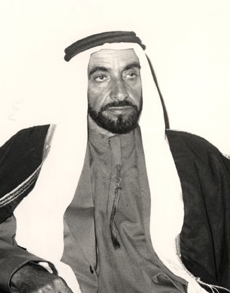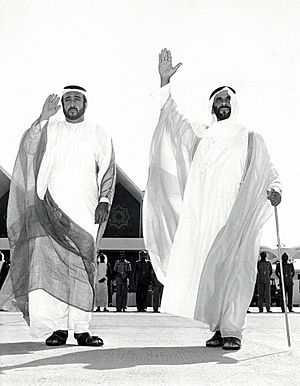Zayed bin Sultan Al Nahyan facts for kids
Quick facts for kids Zayed bin Sultan Al Nahyan |
|||||
|---|---|---|---|---|---|

Sheikh Zayed in 1974.
|
|||||
| 1st President of the United Arab Emirates | |||||
|
In office
|
2 December 1971 – 2 November 2004
|
||||
|
Prime Minister
|
|||||
|
Vice President
|
Rashid bin Saeed Al Maktoum
Maktoum bin Rashid Al Maktoum |
||||
| Predecessor | Post established | ||||
| Successor | Khalifa bin Zayed Al Nahyan | ||||
| Emir of Abu Dhabi | |||||
| Reign | 6 August 1966 – 2 November 2004 | ||||
| Predecessor | Shakhbut bin Sultan Al Nahyan | ||||
| Successor | Khalifa bin Zayed Al Nahyan | ||||
| Born | 6 May 1918 Abu Dhabi (majority view, see text), Emirate of Abu Dhabi, Trucial States (now the UAE) |
||||
| Died | 2 November 2004 (aged 86) Abu Dhabi, United Arab Emirates |
||||
| Burial | Sheikh Zayed Mosque | ||||
| Spouse |
|
||||
| Issue | see list | ||||
|
|||||
| House | Al Nahyan | ||||
| Father | Sultan bin Zayed Al Nahyan | ||||
| Mother | Salama bint Butti Al Qubaisi | ||||
| Religion | Sunni Islam | ||||
Sheikh Zayed bin Sultan Al Nahyan (Arabic: زَايِد بِن سُلْطَان آل نَهْيَان, romanized: Zāyed bin Sulṭān Āl Nahyān; 6 May 1918 – 2 November 2004) was a very important leader from the UAE. He was the first president of the United Arab Emirates from 1971 until he passed away in 2004. Many people call him the founding father of the UAE. He brought together seven different areas, called emirates, to create one strong country. He was also the ruler of Abu Dhabi from 1966 until his death.
Zayed became the ruler of Abu Dhabi on 6 August 1966. He took over from his older brother, Sheikh Shakhbut bin Sultan Al Nahyan. This change happened peacefully with support from his family and the British.
Contents
Sheikh Zayed: Founder of the UAE
Early Life and Family
Zayed was the youngest of four sons of Sheikh Sultan bin Khalifa Al Nahyan. His father ruled Abu Dhabi from 1922 to 1926. Zayed's mother was Sheikha Salama bint Butti. She made her sons promise not to fight each other, and they kept this promise.
Sheikh Zayed was named after his grandfather, Sheikh Zayed bin Khalifa Al Nahyan, who was a great ruler. When Sheikh Zayed was born, Abu Dhabi was one of seven Trucial States along the coast of the Persian Gulf. He loved falconry, which is hunting with trained falcons.
Most people believe he was born in Qasr al-Hosn in Abu Dhabi. Some sources say he was born in Al Ain. He moved to Al Ain in 1927 after his father died. There were no modern schools in the area when Zayed was growing up. He learned about Islam and lived with Bedouin tribes in the desert. This helped him understand the people and their traditional ways of surviving in the harsh climate.
Becoming a Leader

In 1946, Zayed became the governor of the Eastern Region of Abu Dhabi. He was based at Muwaiji fort in Al Ain. This area was poor and had many diseases at the time. When companies started looking for oil, Zayed helped them.
Zayed was very important in solving a land dispute with Saudi Arabia in the 1950s. He helped develop the region and fixed the falaj system. This was a network of water channels that kept the farms in the Buraimi Oasis green and fertile.
Oil was discovered in 1958 and started being exported in 1962. Other family members wanted to use this oil money to improve Abu Dhabi. They felt Sheikh Shakhbut was not spending enough. So, on 6 August 1966, Sheikh Zayed became the new ruler of Abu Dhabi. This change was supported by the whole Al Nahyan family.
Building the UAE
In the late 1960s, Sheikh Zayed hired architects to plan and design the city of Abu Dhabi. He wanted wide roads, beautiful coastal areas called corniches, and a green city. He often used a camel stick to draw his ideas in the sand for the architects.
In 1968, the United Kingdom announced it would leave the Persian Gulf. Sheikh Zayed and Sheikh Rashid bin Saeed Al Maktoum of Dubai decided to form a federation. They invited other rulers to join them to create a strong new nation.
In 1971, after many talks, the United Arab Emirates was formed. Zayed became the first president of the UAE. He was re-elected four more times, serving until his death.
In 1974, Zayed resolved a border disagreement with Saudi Arabia. He also founded the Abu Dhabi Investment Authority in 1976. This became one of the world's largest investment funds.
His Vision and Helpfulness
Sheikh Zayed strongly believed in uniting the emirates. He also wanted cooperation with other countries in the Persian Gulf, like Iran. He believed in talking to solve problems, even about islands that Iran had taken from Sharjah.
Zayed was known for being very generous. He once said it was silly to argue over a small, dry piece of desert, especially when Abu Dhabi had so much oil already. He was willing to share resources with less fortunate neighbors. During talks to form the UAE, he was very generous with Sheikh Rashid of Dubai. He even gave him oil rights that were worth a lot of money. This showed his focus on the bigger goal of uniting the country.
He was a relatively open-minded ruler. He allowed private media, but they were expected to be respectful. He also allowed different religions to build places of worship, like churches and temples. Zayed supported rights for women, such as access to education and work, within traditional values. His views on women's rights were more open than many other leaders in the region.
Zayed was not afraid to speak his mind about events in the Arab world. He was concerned about the people in Iraq and called for an end to economic restrictions on them.
Policies and Charity
When the British left the Persian Gulf in 1971, Zayed created the Abu Dhabi Fund for Arab Economic Development. This fund used some of the UAE's oil wealth to help about forty Islamic nations in Asia and Africa.
Using the country's huge oil money, Zayed built hospitals, schools, and universities. He made sure that UAE citizens could use these services for free. He also gave millions of pounds to good causes around the Arab world and beyond.
Land was often given away for free to families who needed it. His traditional council, called a majlis, was open to the public. Anyone could come and talk to him.
After floods damaged Yemen in 1982, Zayed paid for a new dam to be built in Ma'rib in 1984. This dam helped the country's farming and economy. His ancestors are believed to have come from the Ma'rib area.
Zayed Centre
The Zayed Centre was a place for discussions. However, some of its opinions caused controversy. For example, Harvard Divinity School returned a large gift from Sheikh Zayed because of concerns about the centre's views. Former US President Jimmy Carter accepted an award from the Zayed Centre in 2001, saying it was special because Zayed was his friend.
The London School of Economics also faced protests when it accepted a donation from the Zayed Centre. Despite this, they built a lecture theatre named after Sheikh Zayed. Because of these issues and negative attention, Sheikh Zayed closed the centre in August 2003. He stated that the centre's discussions went against his beliefs in tolerance among different faiths.
His Passing
On 2 November 2004, Sheikh Zayed passed away at the age of 86. He had been dealing with diabetes and kidney problems. He was buried at the new Sheikh Zayed Grand Mosque in Abu Dhabi. His oldest son, Sheikh Khalifa bin Zayed Al Nahyan, had already started taking on more government duties in the 1980s. After his father's death, he became the ruler of Abu Dhabi and the new president of the United Arab Emirates.
His Legacy and Memorials
Sheikh Zayed is remembered through many places and awards:
- Zayed University, a university in Abu Dhabi and Dubai.
- Shaikh Zayed University in Afghanistan, built with his help.
- Sheikh Zayed City in Egypt, built with a donation from Abu Dhabi.
- The Zayed International Prize for the Environment and Zayed Future Energy Prize are named after him.
- Airports in Albania and Pakistan are named in his honor.
- Hospitals and medical colleges in Pakistan are named after him.
- The Stockholm Mosque in Sweden is also named after him.
- A lecture theatre at the London School of Economics bears his name.
- A school in Chechnya and a wing at The World Center of Birds of Prey in Idaho are named after him.
- The current dam in Ma'rib, Yemen, is called "Zayed Dam."
- Zayed Town in Bahrain was financed by him.
- A street in Montenegro and a main street in Tunis are named for him.
- The Sheikh Zayed Tower at the Johns Hopkins Hospital is named in his honor.
- The Sheikh Zayed Institute for Pediatric Surgical Innovation in Washington, DC.
- The Sheikh Zayed Children Welfare Centre in Kenya.
- In 2018, the "Year of Zayed" celebrated 100 years since his birth.
The Founder's Memorial
In 2018, a special memorial called the Founder's Memorial was opened in Abu Dhabi. It has a beautiful garden and a special artwork called The Constellation. This artwork is dedicated to Sheikh Zayed's memory and celebrates his life and what he achieved.
Family Life=
Zayed bin Sultan had many children. He had 18 sons. Here are some of his children:
| Name | Lifespan | Notes |
|---|---|---|
| Khalifa bin Zayed Al Nahyan | 7 September 1948 – 13 May 2022 | Former President of UAE and Ruler of Abu Dhabi |
| Mohamed bin Zayed Al Nahyan | 11 March 1961 (age 64) | Current President of UAE and Ruler of Abu Dhabi |
| Hamdan bin Zayed Al Nahyan | 1963 (age 62–63) | |
| Hazza bin Zayed Al Nahyan | 1965 (age 60–61) | |
| Tahnoun bin Zayed Al Nahyan | 4 December 1969 (age 56) | |
| Mansour bin Zayed Al Nahyan | 20 November 1970 (age 55) | |
| Abdullah bin Zayed Al Nahyan | 30 April 1972 (age 53) | |
| Saif bin Zayed Al Nahyan | 1968 (age 57–58) | Deputy Prime Minister of the United Arab Emirates |
| Hamed bin Zayed Al Nahyan | 1971 (age 54–55) | |
| Ahmed bin Zayed Al Nahyan | (1968–26 March 2010) | |
| Issa bin Zayed Al Nahyan | ||
| Nasser bin Zayed Al Nahyan | (1969–2 June 2008) | |
| Saeed bin Zayed Al Nahyan | (born 1965) | |
| Falah bin Zayed Al Nahyan | 7 November 1970 (age 55) | |
| Dhiyab bin Zayed Al Nahyan |
See also
 In Spanish: Zayed bin Sultán Al Nahayan para niños
In Spanish: Zayed bin Sultán Al Nahayan para niños


